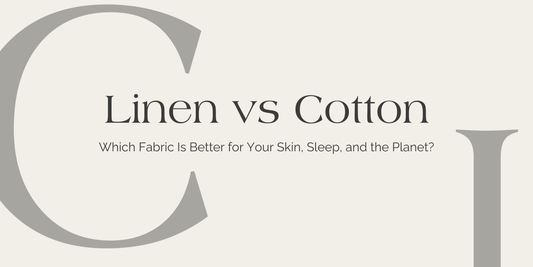Executive Summary
Choosing between linen sheets vs cotton often comes down to comfort, climate, durability, and care. While cotton is familiar and widely available, linen offers better breathability, long-term softness, and higher durability. This guide compares the two in plain terms to help you make a smart, lasting decision for your bed—and your sleep.
When it comes to high-quality bedding, two materials usually dominate the conversation: linen and cotton. Both are timeless, trusted, and widely used across households. But in the growing conversation around bedding that lasts, adapts to your sleep habits, and actually improves with time, linen sheets vs cotton becomes a decision worth thinking through.
This guide walks through the real, practical differences between the two—beyond thread count or hype.
Breathability & Temperature Control
Let’s start with what you’ll feel first: temperature. In the linen sheets vs cotton comparison, linen comes out on top for airflow and cooling.
Its open weave and natural flax fibers allow air to circulate freely, pulling heat and moisture away from your body. Even if you’re a hot sleeper or live in a humid climate, linen helps you stay dry. It can absorb up to 20% of its weight in moisture without ever feeling damp.
Cotton is breathable too, but it traps more heat and wicks moisture less efficiently—often leaving you feeling warm or clammy by morning.
Strength & Longevity
If you’re making an investment in bedding, you want it to last. In the linen sheets vs cotton comparison, linen comes out ahead in long-term durability.
Linen fibers are stronger than cotton—about 30% stronger, to be exact. That strength means your sheets won’t thin out or pill with repeated washes. In fact, linen becomes softer and more comfortable over time. It wears in, not out.
Cotton sheets, even high-end varieties, tend to break down more quickly. Over time, they lose structure, fade, and develop weak spots—especially with frequent washing.
Texture & Feel
If you're used to cotton’s ultra-smooth finish, linen might feel like a shift at first—but it's a good one. In the linen sheets vs cotton debate, texture is where preferences start to shift.
Cotton sheets, especially in sateen or percale weaves, are smooth and crisp right out of the packaging. But that softness often comes from chemical finishing that wears off over time.
Linen starts off with more texture. But as it's washed and used, the fibers relax, soften, and take on a unique, airier softness. It doesn't need help to become cozy—it naturally gets there.
Many people who switch from cotton to linen say they can’t go back. It’s breathable, weightless, and soft in a way that feels lived-in—not flat.
Aesthetics & Design Appeal
Visually, linen sheets vs cotton sheets offer distinctly different looks. Cotton gives you a cleaner, more traditional appearance, while linen brings character and texture that feels effortless and considered.
Linen sheets drape effortlessly, wrinkle naturally, and have a soft matte finish that looks intentional. Whether styled perfectly or left undone, they still manage to look put together. The texture adds depth, which works in both modern and classic interiors.
Cotton can look sleek when ironed or freshly laundered, but it requires more upkeep to maintain that polished aesthetic.
Sustainability
In the linen sheets vs cotton sustainability conversation, linen comes out ahead. It’s made from flax—a crop that needs little water, no irrigation, and minimal chemicals to grow. Every part of the flax plant is used, making the production process efficient and low-waste.
Cotton, especially conventionally grown cotton, is far more resource-intensive. It requires large amounts of water, synthetic fertilizers, and pesticides, resulting in a much larger environmental footprint.
Compared to flax, cotton has a heavier impact on land and water use—making linen the more responsible choice from field to fabric.
Allergy-Friendly & Freshness
If you have sensitive skin, allergies, or just want fresher sheets between washes, linen has the edge. In the linen sheets vs cotton comparison, linen’s natural properties make it better at keeping your bed clean and irritation-free.
It’s hypoallergenic, antimicrobial, and quick-drying—resisting dust mites, mold, and bacteria. Linen also wicks moisture effectively, helping your sheets stay dry and fresh for longer.
Cotton is gentle too, but it holds more moisture and dries slower, which can lead to buildup if not washed frequently.
Care & Maintenance
Despite what you might have heard, linen is low maintenance.
You can machine-wash and tumble dry it on low. It doesn’t need ironing unless you prefer a crisper look. Linen’s natural wrinkles are part of its charm—and part of why it looks so good. The more you wash it, the softer and easier it gets.
Cotton sheets, especially those with higher thread counts, often need more delicate care. They’re more prone to pilling and can look worn faster if not treated gently.
The Verdict: Linen Sheets vs Cotton
If you love what’s familiar and want a smooth, low-texture sheet that looks crisp, cotton may still be your go-to. But if you're looking for sheets that offer better airflow, stronger fibers, long-term comfort, easier care, and a more natural look and feel, linen is the smarter choice.
It’s not about trend. It’s about materials that age well, feel better, and demand less from the planet and from you.
Want to Learn More?
If you went through this Linen Sheets vs Cotton guide and you are considering linen for the first time, start with the basics. Our Linen Sheets Care Guide walks you through washing, softening, and storing your bedding the right way.
And it’s not just a matter of preference—studies support it. According to a study published by the National Institutes of Health, linen’s natural antibacterial and moisture-regulating properties make it especially effective in reducing microbial growth, supporting both skin health and sleep quality.





